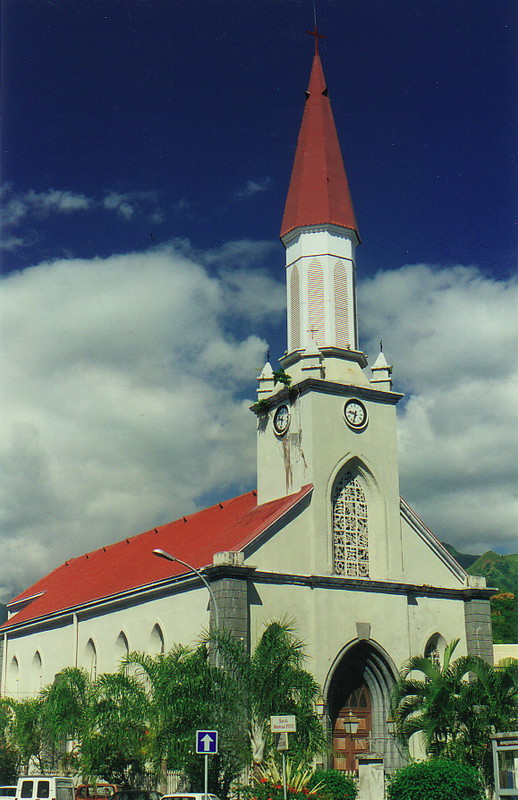
Papeete, the capital of French Polynesia, is the biggest settlement on Tahiti and the only place in the territory that can be called a city (with a population of around 150,000). It is also a mixed bag. I found the very idea of a population explosion delightful after such a long spell in the enforced hermitage of Zeke, and as we approached the city lights, the smell of thousands of bodies and their excretions drifted across the tide.
I instantly recognised it, a combination of exhaust, sewage and sweat. I suddenly realised that I've spent most of my life living in this smell, so much so that I've also spent most of my life not noticing it. Mangareva reminded me that healthy earth and trees smell; Papeete reminded me that humans smell too. I revelled in it.
But Papeete, despite my initial euphoria, wasn't that flash. It's an intriguing combination of French culture, Polynesian flair and tropical weather, but it's a pretty smelly and dirty place. As a place to visit it's interesting, but only that, and the landscape around the city – Tahiti with its high mountains and Moorea, the neighbouring island, with its jagged peaks – is rather more enticing and exotic than the town itself.
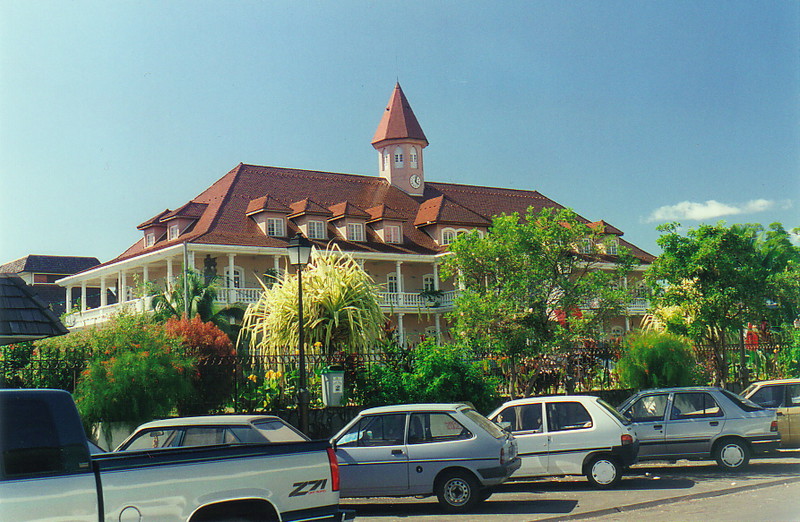
The quay was an interesting place to observe the oddities of Papeete, like the huge Club Med ships that frequent the Society Islands, full of holidaymakers who, when asked, are convinced that the huge sails on those boats actually push the things along (they're actually engine driven, with four huge gibs stuck on to make them look good when sailing).
Perhaps the most amusing and downright French spectacle was the pedestrian crossing just opposite the boat. In typical Parisian fashion, the cars have absolutely no intention of stopping for mere pedestrians, which produces a collection of bemused and critical Americans and English standing on the crossing and mumbling about how rude these French drivers are.
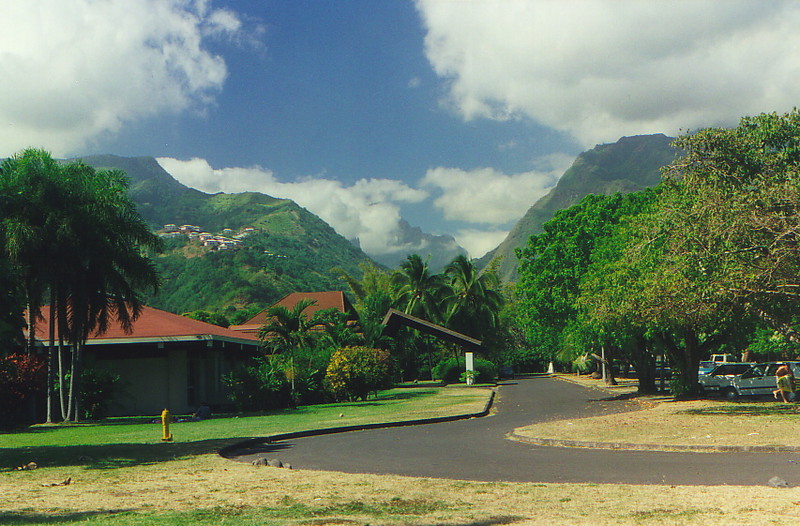
One fool Englishman walked out into the road, looking the wrong way (as they drive on the right here, of course) and promptly got the shit scared out of him as a car slammed on the anchors and skidded to a halt inches from his knees. The Englishman launched into an angry tirade against the driver, shouting, 'Are you drunk?' in very loud English, which had the same effect on the driver as Belgian sitcoms would on the rest of us; he knew what the Pommy guy was going on about, but how relevant was it to him?
As the Tahitian casually drove off, thinking to himself that the world would be a better place if the tourists calmed down, the English guy raved on at his poor travelling companions, re-enacting Agincourt in all but physical violence. There's no doubt, though, that Papeete is a pedestrian's nightmare, with blind corners coinciding with a disappearing pavement, drivers who think the whole world is Le Mans, scooters that treat the sidewalk as an extension of the road, and parking rules that were obviously made to be broken.
Tahitian Dancing
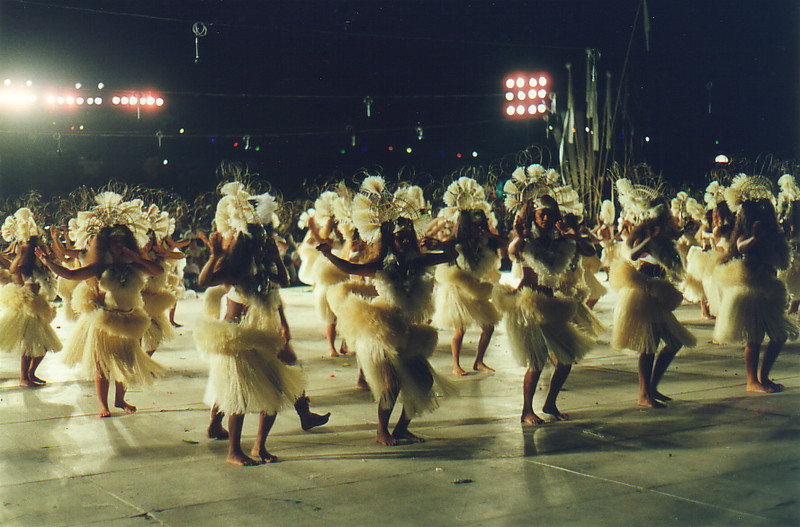
Still, we did see some local culture, mainly in the form of real Tahitian dancing. As part of the Bastille Day fête (Bastille Day being on 14th July, the excuse for a long celebration in Tahiti called the Heiva) there was a three-week long dancing contest, and for most of the nights we were in Papeete, you could watch the various teams strut their stuff in a makeshift stadium erected by the harbour. It was rather fun; the way those girls wiggle their hips is enough to make otherwise healthy men get palpitations, and even though the dancing we'd seen in Makemo had been more raw and powerful, the Tahitian programme of dance, choral ditties and instrumentals was certainly entertaining. Especially when the grass skirts and amazingly ornamental flower hats1 started to fall apart with the vigorous shaking they were getting...
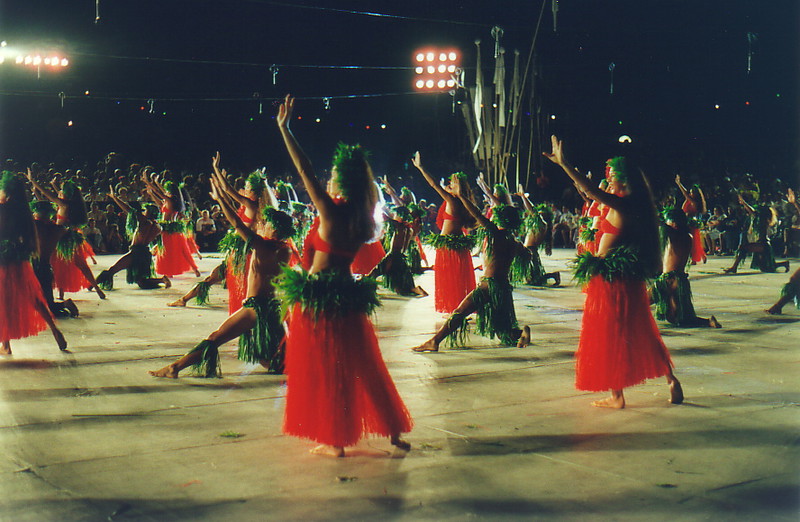
There is one thing that bothers me about Tahitian music, though. They have the most powerful drummers that you're likely to see, but over the drumming they play – wait for it – the ukulele. Now quite what the ukulele is doing here, I don't know; perhaps the Tahitians invented the bloody thing, but my appreciation of Polynesian rhythms is somewhat scarred by the fact that bits of it remind me of George Formby. That's not good, even if the drum sounds are second to none.
My visit to the Musée des Îles et de Tahiti confirmed what I dreaded: the stringed instruments used by the islanders were brought in by the Europeans, though quite why a nation of powerful music makers should embrace such a tinny instrument and include it in their every composition is beyond me. The native instruments on display were far more interesting; the pahu drum, a hollowed out tree trunk popular in eastern Polynesia; the to'ere, a split drum popular in western Polynesia; triton conch shells that make the most amazingly loud howl you've ever heard; bamboo nose flutes that you wouldn't want to play after someone else already has; reed pipes; and, from the Marquesas, a type of xylophone. That's more like it: instruments with attitude.
Wandering Round Tahiti
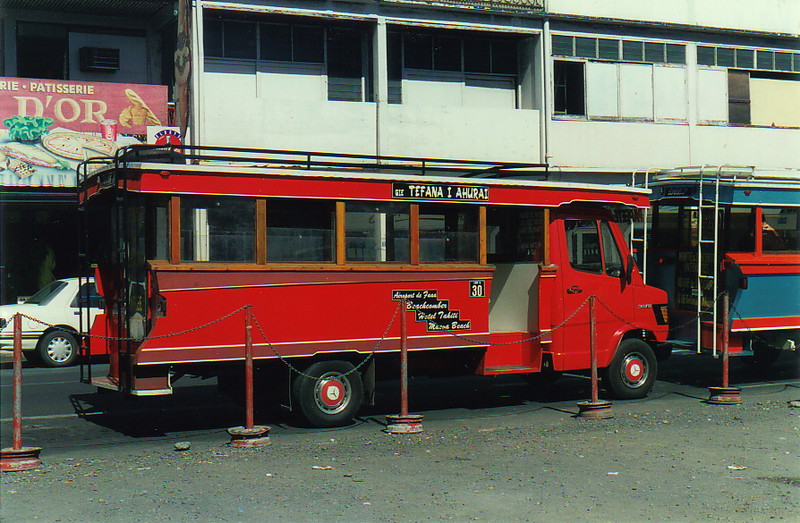
Another result of my visit to the Musée was my rediscovery of the joys of walking. Apart from a few stints in Mangareva and the odd beach walk in the Tuamotus, I hadn't been on any serious walks since Tongariro and I really missed it. So I took le truck to the museum – le truck being the local bus, a wacky combination of bus and truck, and cheap to boot – but decided to walk back, it being a beautiful day. The 15km, three-hour jaunt wasn't exactly picturesque – it followed the dirty coast road back to Papeete – but it felt good, and woke up those walking muscles that just don't get any exercise on the sea.
The rediscovery of walking opened up Papeete like never before. I hadn't had the time or the inclination to do much exploring in the first week, as I'd promised Rob I'd help him with the varnishing, a job that took a lot longer than anticipated, but when that was done, I declared myself a non-working guest on the boat and started to explore.
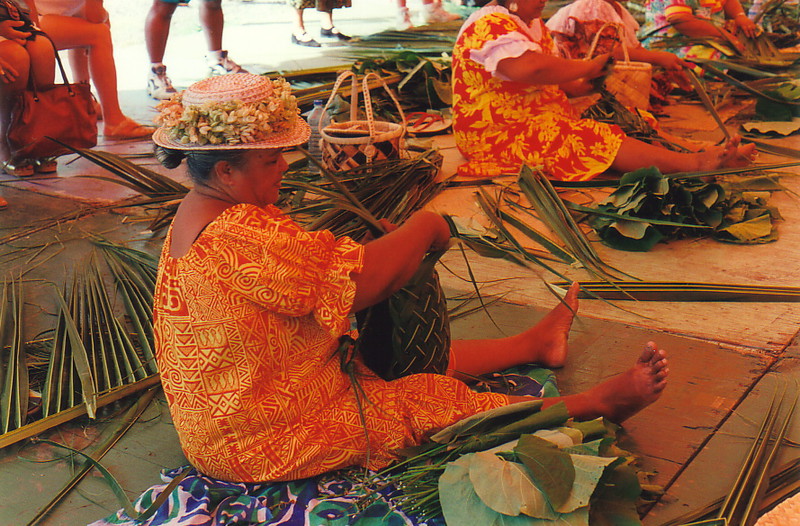
In a vain attempt to find some aspect of Tahiti that wasn't entirely spoiled by exposure to western tourism, I spent one day visiting a craft fair, which turned out to be an intriguing combination of craft shops (selling, mostly, tourist-friendly junk, but pleasant junk nonetheless) and a little arena in which all sorts of competitions and displays took place. I spent the best part of a day watching a basket-weaving contest, in which a group of large Tahitian women2 sat around nattering and moving their hands in well-practised combinations to produce intricate baskets and hats. There was also a race to create these strange traditional shapes out of big, flat, round leaves; a fashion show, in which three lovelies from the Tuamotus showed us various ways of tying a pareo (the Tahitian equivalent of the sarong or saree); dancing, which interestingly featured some of the dancers I'd seen practising in Amanu; and a kids' dancing competition which managed to show up the fundamental differences between male dancing and female dancing.
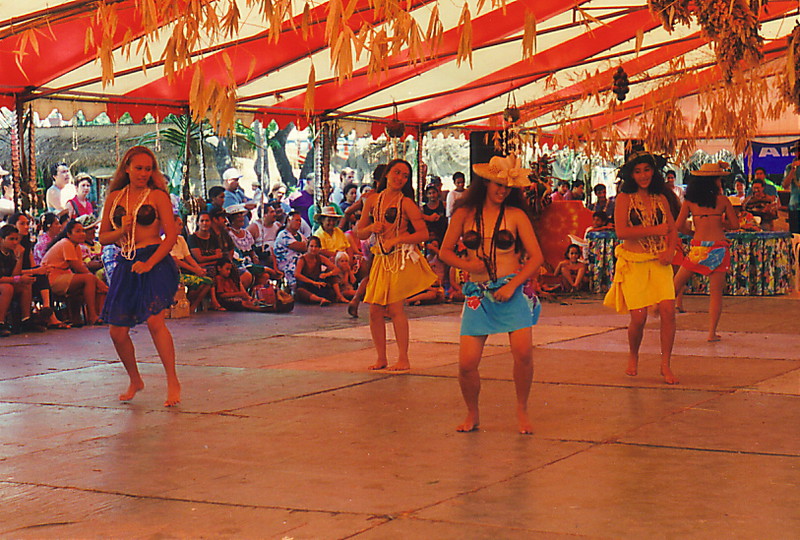
Male dancing and female dancing are quite different to each other, although they often dance at the same time. The males tend to leap around in a more violent manner, with their mainstay being to crouch down and knock their knees together very quickly; the females waggle their hips from side to side incredibly fast, while keeping their shoulders absolutely still. It's quite a sight when there are about 100 dancers on the stage, the girls all wobbling hips in time, and the boys all knocking knees together, with serious drums smashing in the background, and the tinny lilt of a ukulele sounding like a lost little girl at a footy match. And as for the costumes... well, the coconut bra might not be the most comfortable accoutrement in the world, but it does wonders for a man's libido when he's been cooped up in a 36 ft yacht for so long.
Le Retro
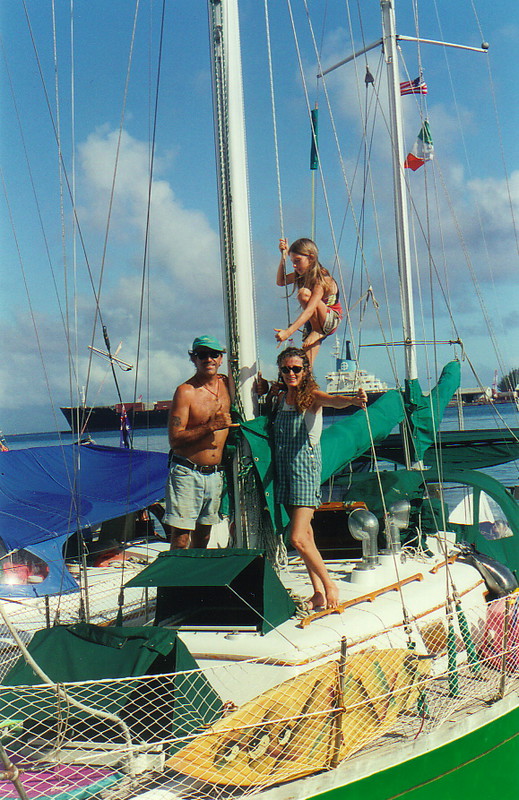
The ice creams at Le Retro, the café over the road from the yacht quay, were hard to beat. Not only were there some 30 flavours to choose from, but it became quite a social spot for the yachties: 'Fancy an ice cream?' became a byword for 'Stop trying to fix that and take a break.' Many a tale of derring-do was relayed over une glace du chocolat at Le Retro, I can tell you.
Indeed, the social life on the quay was buoyant, to say the least. On one side of us were very friendly Canadians Dave and Dorothy in Kabloona III, and on the other was the ketch Tir Na Nog, with its crew of Merl (known to his mates as Claw), his wife Mary (who had the most delightful Irish accent) and their daughter, eight-year-old Crystal, who was a vivacious American-accented tornado. Then there were all the other boats around, some of whom we had met in the Gambiers, and some of whom we met through others. Hearing stories from other yachties of awful passages, sea sickness, wonderful anchorages and the ups and downs that form the fabric of cruising made me feel that at least I wasn't alone in feeling ill at ease on the sea.
We never got to see Illusion, who'd set off for Tahiti soon after us, but Jan van Gent did pull into the quay on the day before I flew out, having spent a couple of weeks over in Moorea, Tahiti's sister island. It was genuinely great to see Richard and Gail again; such good friendships are forged out there on the ocean.
Real Food!
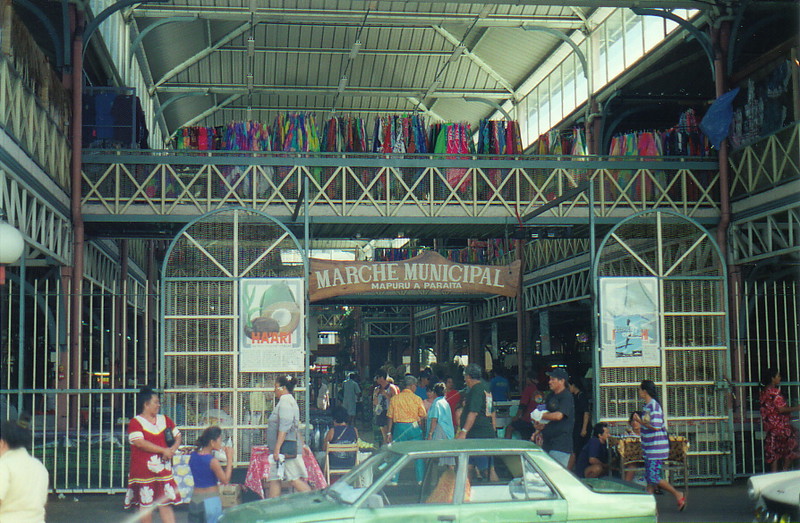
Food and drink, so long a subject of fantasies and restrictions, was initially a wonderful experience, and gradually it became normality again. Drinking beer; eating baguettes and the most amazing French contribution to international cuisine, the pain au chocolat; ice cream; real coffee; real milk... these things transformed my life more than I would have anticipated.
I rediscovered alcohol after four months of abstinence, spending one night guzzling over nine pints of Hinano beer in a slightly worryingly self-destructive solo beer session, the product of internal stress over having to wait for my escape to Brisbane and a general disappointment at Papeete; the next day's hangover served me right, and proved that getting drunk on a boat is no fun at all.
The Reality of Yachting
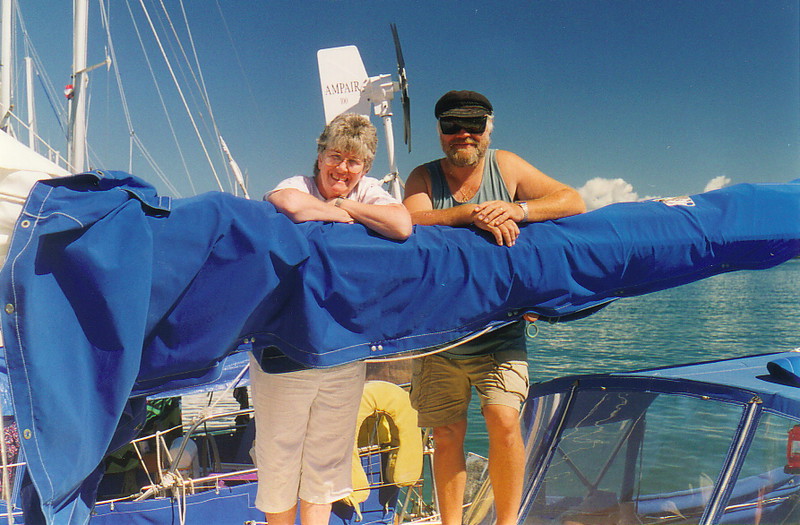
Papeete quay also showed me once and for all the ugly side of cruising – in fact, whoever adopted the word 'cruising' for the task of getting a yacht round the world obviously hadn't done it themselves (one yachtie I met described 'cruising' as 'fixing your boat in exotic locations', and it was a deadly accurate observation). It's the constant battle to keep your yacht shipshape, a considerable challenge when the sea is constantly doing its best to eat away at your pride and joy. Dave and Dorothy had their engine die on them, and by the time I left Tahiti the problem had graduated from a possible electrical fault in the inverter to a burnt-out alternator. Rob had to fix his broken anchor winch, a thankless task that required a whole day's hacking around to botch a solution. Claw and Mary had to survive without their wind generator after it broke down, requiring a courier to take it to Hawaii to be mended. All along the quay yachts were having to stay longer than originally hoped due to ripped sails, dents in the hull, damaged equipment and, in one case, a badly broken leg. At least two yachts I saw had decided enough was enough, and were trying to sell their floating homes, with little success.
So next time you look at those beautiful pictures of yachts sitting in blue coral lagoons, think of the effort involved. A sailing holiday? That sounds like an oxymoron to me. I heard of an outfit that charged US$4000 for two weeks' sailing experience, where you went out on a yacht and learned about sailing by actually doing it – all of it. The quaysiders' view was that anyone who paid US$4000 for two weeks of having to wash up, cook, reef the main in high winds and pump out the bilges must be completely insane. I didn't tell them that I considered anyone who would pay US$100,000 for a yacht in the first place completely insane too.
Leaving Zeke and Polynesia
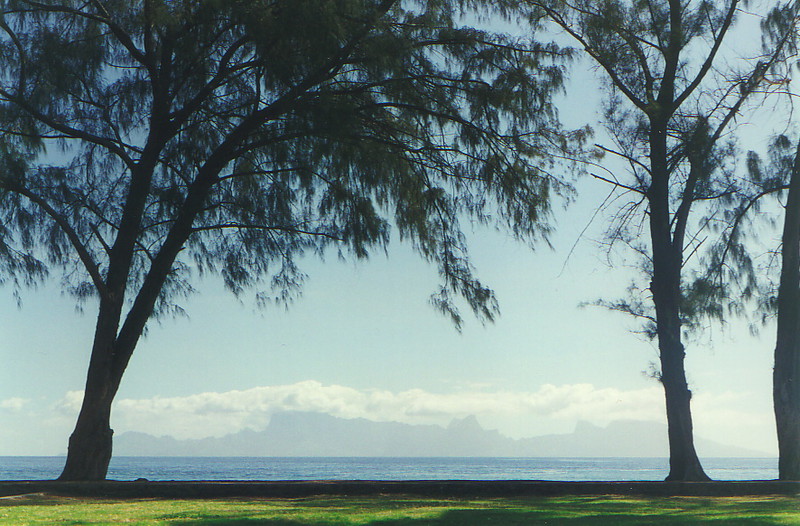
Due to my unexpected departure, Rob had to find more crew, so Zeke became an interview zone for prospective sailors who had replied to the advert tacked on the bow (an advert noticed by plenty of people as we were tied to the yacht quay). Some were idiots, some were potentially good, and some were good choices, but every interview made me feel a little sad to be leaving as Rob reeled off the plans for the trip, and the places he was going on to visit: Fiji, Samoa, Tonga, the Cook Islands, Vanuatu and the rest of the Polynesian pantheon. But it didn't take much to realise that leaving the boat was still the best thing I'd done on the whole trip; sometimes you just have to accept that you don't have sea legs and are never going to get them.
One thing I'll never forget was the feeling of euphoria when I shook Rob's hand and finally stepped off Zeke for the last time. No more swell! No more seasickness! No more sailing to contend with! I said goodbye to my newfound friends on the quay and hopped onto the airport bus; I was back on my own two feet again, with nobody to answer to or worry about, and I felt unshackled. As Tom Wolfe once wrote, you're either on the bus or off the bus, and I was well and truly back on the bus.
1 San Francisco might have flowers in its hair, but Tahiti has them in its hair, round its neck, on its clothes... everywhere. Never have I seen a people so happily obsessed with flowers, to the point of it being strange to see someone without a flower somewhere on their body. It makes a welcome change from drab pinstripe suits.
2 This is a confusing issue. Many older women in Polynesia are huge, and wear these awful Mother Hubbard dresses that the missionaries brought in to cover up the previously naked natives. I had been told that Polynesian men like their women on the large side, and that being fat is regarded as a good thing, rather than the social stigma it is in the stick-thin fashion consciousness of the western world; this struck me as a particularly healthy attitude, as there's nothing remotely attractive about anorexic models. There's only one odd thing: Miss Tahiti is a gorgeous, slim girl, whom I was lucky enough to watch dancing at the craft show, and the girls who shake their hips at the dance contests are hardly what one would call overweight. Somewhere between young girl and old woman there occurs a metabolic change of immense proportions, literally, and it's weird.